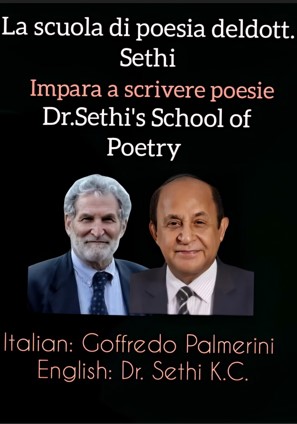Come imparare a comporre poesie impressive
Benvenuti alla Scuola di Poesia del Dr. Krishan Chand Sethi, dove l’arte di creare poesie impressive e attraenti viene esplorata in profondità. Questa guida completa, scritta dal Dr. Sethi, mira a fornire le tecniche, i metodi e le intuizioni necessarie per padroneggiare il linguaggio poetico ed esprimere i propri pensieri in modo creativo. Traendo ispirazione dall’ampia esperienza del Dr. Sethi e dagli studi recenti presso un’Accademia internazionale di Inglese in Nuova Zelanda, questo libro offre una combinazione unica di approcci tradizionali e contemporanei alla scrittura poetica. Il Dr. Sethi è orgoglioso di collaborare con il rinomato giornalista italiano e icona dei media Goffredo Palmerini, che ha unito le forze con il Dr. Sethi per pubblicare questo libro in lingua italiana per aiutare la creatività poetica del popolo del suo paese e degli altri italiani che vivono all’estero.
L’Essenza della Poesia
Capire la natura della poesia è il primo passo verso la maestria poetica. La poesia si distingue per la sua capacità di evocare emozioni profonde e di creare connessioni attraverso l’uso del linguaggio. Le definizioni di poesia variano tra studiosi letterari, ma tutte riconoscono il suo potere unico. Esplorando il contesto storico della poesia, dal periodo antico ai tempi moderni, si può comprendere come la poesia si sia evoluta e adattata nel corso dei secoli.
Il linguaggio è fondamentale nella creazione di poesie d’impatto. L’uso di metafore e similitudini, come “La vita è una tela e ogni giorno un colpo di pennello,” crea immagini potenti e connessioni significative. Allo stesso modo, l’allitterazione e l’assonanza, come in “Venti sussurranti vagavano malinconicamente,” aggiungono musicalità e ritmo al testo. Onomatopee e giochi di parole, come “Le api ronzavano industriosamente,” arricchiscono l’esperienza sensoriale del lettore.
Dettagli sensoriali nella Poesia
L’uso di immagini visive e dettagli sensoriali rende le poesie vivide e memorabili. Un linguaggio descrittivo, come “Il tramonto cremisi dipingeva il cielo con pennellate d’oro e ambra,” crea forti immagini visive. Simbolismo e allegoria, come “Una singola rosa su una tomba,” aggiungono significati più profondi alla poesia. L’equilibrio tra il linguaggio descrittivo e il tema generale della poesia è essenziale per coinvolgere i sensi visivi del lettore.
L’immaginazione uditiva arricchisce l’atmosfera e il tono di una poesia. Descrivere suoni, come “Le foglie frusciavano come segreti sussurrati nel crepuscolo,” evoca atmosfere specifiche. La musicalità nel linguaggio, come “Il ticchettio della pioggia sul tetto,” crea ritmo e tono. Usare il suono per creare un’esperienza uditiva immersiva nella poesia rende il testo una esperienza multisensoriale.
Profondità emotiva nella Poesia
Usare esperienze personali per esprimere emozioni autentiche è fondamentale nella poesia. Attingere dalla propria vita, come in “Nel silenzio della notte, sentivo il peso delle parole non dette,” trasmette un senso di rimpianto e introspezione. La poesia confessionale, come quella di Sylvia Plath, è caratterizzata da una scrittura vulnerabile e onesta. Mantenere l’autenticità garantisce che le emozioni personali risuonino con il lettore.
Bilanciare esperienze personali con temi universali amplia l’appeal della poesia. Temi come l’amore, la perdita e la speranza, espressi in versi come “L’amore, un’ombra fugace, danzava al chiaro di luna,” sono riconoscibili e toccanti per tutti. Allineare il tono emotivo con l’emozione intesa, come “Una dolce tristezza persiste come una stella che svanisce,” rafforza l’impatto emotivo della poesia.
Sperimentare con le forme
Esplorare varie forme poetiche tradizionali, come sonetti e haiku, e comprendere la loro struttura e regole, aiuta a sviluppare la disciplina e a sfidare la creatività. Un sonetto di Shakespeare o un haiku di Basho offre una base strutturata per l’espressione poetica. Altre forme tradizionali, come villanelle e limerick, offrono ulteriori opportunità per sperimentare.
Le forme moderne di poesia, come il verso libero e la poesia concreta, offrono più libertà e flessibilità. Il verso libero consente ai poeti di concentrarsi sul ritmo naturale senza regole rigide, come nella linea “Il sole tramonta oltre l’orizzonte, lasciando tracce del suo calore nella fresca brezza serale.” La poesia concreta, che utilizza l’arrangiamento visivo per completare il tema della poesia, aggiunge una dimensione unica all’espressione poetica. Una poesia a forma di albero, ad esempio, rafforza visivamente il tema della poesia e la rende più coinvolgente.
Raffinare la Poesia
Il processo di revisione è determinante per creare poesie rifinite e d’impatto. Le prime bozze spesso catturano l’essenza grezza di un’idea, ma la revisione migliora l’immaginazione e la profondità. Una linea semplice come “Le stelle sono luminose” può essere trasformata in “Le stelle punteggiano il cielo, scintillando come diamanti sparsi su velluto” attraverso una revisione attenta. Più giri di revisione permettono ai poeti di affinare il loro lavoro, migliorandone la chiarezza e l’impatto. Essere aperti ai cambiamenti e ai miglioramenti è essenziale per creare la migliore versione possibile di una poesia.
Il feedback gioca un ruolo vitale nella crescita e nel miglioramento di un poeta. Workshop e revisioni tra pari forniscono nuove prospettive e critiche costruttive che possono aiutare i poeti a vedere il loro lavoro sotto una nuova luce. Condividere il proprio lavoro con un gruppo fidato o partecipare a workshop di poesia può fornire feedback preziosi e ispirare nuove idee. Tecniche di editing, come l’aggiustamento delle interruzioni di linea e delle scelte di parole basate sul feedback, possono migliorare significativamente il flusso e l’impatto di una poesia. Rimanere aperti di mente e considerare le critiche costruttive è essenziale per la crescita come poeta.
Imparare dai Maestri
Imparare dai maestri della poesia offre lezioni e ispirazione inestimabili. La lettura attenta delle opere di grandi poeti, come “La strada non presa” di Robert Frost, consente ai poeti di comprendere i temi, la forma e il linguaggio che rendono queste poesie potenti e durature. Emulare stili, come scrivere nello stile conciso ed evocativo di Emily Dickinson, aiuta i poeti ad apprendere attraverso l’imitazione e l’adattamento. Esplorare studi tematici, come i temi dell’amore nelle opere di Pablo Neruda, approfondisce la comprensione di come i poeti possono affrontare temi universali nel loro lavoro.
Integrare le prospettive accademiche
Integrare le prospettive accademiche nella scrittura poetica può affinare ulteriormente l’arte del poeta. La critica letteraria, come lo studio dei saggi critici di T.S. Eliot sulla tradizione poetica, offre preziose intuizioni sui framework che modellano l’interpretazione poetica. La teoria poetica, come i principi dell’Immagismo di Ezra Pound, offre linee guida per migliorare la chiarezza e la precisione poetica. Comprendere il contesto storico, come l’impatto del Romanticismo sulla poesia di William Wordsworth, consente ai poeti di riconoscere come i movimenti storici influenzano i temi e gli stili poetici. Bilanciare le intuizioni accademiche con la creatività personale arricchisce il lavoro del poeta e approfondisce la loro comprensione dei principi poetici.
Pubblicare e condividere la Poesia
Navigare nel panorama dell’editoria poetica è un aspetto importante del percorso di un poeta. Inviare poesie a riviste letterarie, come “The New Yorker,” richiede la comprensione delle linee guida e dei processi di invio. L’auto-pubblicazione, attraverso piattaforme come Amazon, offre un percorso alternativo con i suoi vantaggi e sfide. Partecipare a concorsi di poesia e contribuire ad antologie può fornire riconoscimento ed esposizione. Scegliere il miglior percorso di pubblicazione per il proprio lavoro e seguire i passaggi necessari garantisce che la propria poesia raggiunga un pubblico sempre più vasto.
Autore: Dr.Sethi K.C.
Daman India
Co-autore: Goffredo Palmerini, Italia
(per l’edizione italiana)
Dr. Sethi’s School of Poetry: Learn Compiling Impressive Poetry
Welcome to Dr. Sethi’s School of Poetry, where the art of crafting impressive and attractive poetry is explored in depth. This comprehensive guide, authored by Dr. Sethi K.C., aims to equip you with the techniques, methods, and insights necessary to master poetic language and express your thoughts creatively. Drawing from Dr. Sethi’s extensive experience and recent studies at an International English Academy in New Zealand, this book offers a unique blend of traditional and contemporary approaches to poetry writing.
Dr. Sethi feels proud to work with Mr. Goffredo Palmerini, a renowned journalist and media icon from Italy, who has joined hands with Dr. Sethi to publish this book in Italian. This collaboration aims to help the people of Italy and Italians living abroad, making the profound insights and techniques of poetry accessible to a wider audience.
Understanding the essence of poetry is the first step in mastering this art form. Poetry distinguishes itself from other forms of writing through its unique use of language, rhythm, and emotion. By exploring various definitions of poetry from literary scholars, we can gain insight into how poetry is perceived and defined by different experts. This exploration provides a foundation for appreciating the depth and diversity of poetry, allowing us to embrace its fluidity and ability to transcend rigid definitions. Poetry is a timeless and dynamic art form, continually evolving to reflect the human experience.
The power of language in poetry cannot be overstated. The use of metaphors and similes, for example, creates powerful imagery and connections that resonate with readers. A metaphor like “Life is a canvas, and every day a brushstroke” evokes a vivid picture and a deeper understanding of the human experience. Similarly, alliteration and assonance add musicality and rhythm to poetry, enhancing its auditory appeal. An example of this is the phrase “Whispering winds wandered wistfully,” where the repetition of the ‘w’ sound creates a soothing and rhythmic effect. Onomatopoeia and wordplay further enrich the sensory experience of poetry, making it more immersive and engaging.
Visual imagery plays a crucial role in creating vivid and memorable poems. By utilizing descriptive language, poets can paint pictures in the minds of their readers. A phrase like “The crimson sunset painted the sky with strokes of gold and amber” conjures a beautiful and vivid image, making the poem more impactful. Symbolism and allegory also add depth to poetry, allowing poets to convey complex ideas and emotions through simple images. For instance, a single rose on a grave can symbolize love, loss, and remembrance, adding layers of meaning to the poem.
Auditory imagery, on the other hand, enhances the atmosphere and mood of a poem. Sound descriptions, such as “The leaves rustled like whispered secrets in the twilight,” evoke a specific atmosphere and create an immersive auditory experience. The use of musicality in language, like “The clatter of rain on the rooftop,” adds rhythm and mood, making the poem more engaging and evocative. By incorporating sound into their poetry, poets can create a multi-sensory experience for their readers.
Personal emotions are the heart of poetry, providing depth and connection. Drawing from life experiences allows poets to convey authentic emotions that resonate with readers. For example, a line like “In the silence of the night, I felt the weight of unspoken words” conveys a sense of regret and introspection. Confessional poetry, exemplified by the emotionally raw poems of Sylvia Plath, demonstrates the power of writing with vulnerability and honesty. By tapping into their own emotions, poets can create resonant and powerful poetry that speaks to the human experience.
Addressing universal themes like love, loss, and hope broadens the appeal and impact of poetry. These themes are relatable to a wide audience, allowing poets to connect with readers on a deeper level. For instance, a line like “Love, a fleeting shadow, danced in the moonlight” captures the elusive and transient nature of love, making it relatable to many. The emotional tone of a poem should align with the intended emotion, as seen in a phrase like “A gentle sadness lingers like a fading star,” which evokes a sense of melancholy. By balancing personal experiences with universal themes, poets can create poetry that is both intimate and widely resonant.
Experimenting with different poetic forms allows poets to explore various ways of expressing their ideas. Traditional forms like sonnets and haikus have specific structures and rules that challenge poets to be creative within constraints. Understanding the structure of Shakespeare’s sonnets or Basho’s haikus, for example, can provide valuable insights into the disciplined creativity required to write in these forms. Villanelles and limericks offer different challenges and opportunities for experimentation. Dylan Thomas’ “Do not go gentle into that good night” is a powerful example of a villanelle, showcasing the emotional intensity and repetitive structure of this form.
Modern forms of poetry, like free verse and concrete poetry, offer more freedom and flexibility. Free verse allows poets to focus on natural rhythm without strict rules, as seen in a line like “The sun sets beyond the horizon, leaving traces of its warmth in the cool evening breeze.” Concrete poetry, which uses visual arrangement to complement the poem’s theme, adds a unique dimension to poetic expression. A poem shaped like a tree, for instance, visually reinforces the poem’s theme and makes it more engaging.
The revision process is crucial for creating polished and impactful poetry. First drafts often capture the raw essence of an idea, but revision enhances imagery and depth. A simple line like “The stars are bright” can be transformed into “Stars punctuate the sky, shimmering like scattered diamonds on velvet” through careful revision. Multiple rounds of revision allow poets to refine their work, improving its clarity and impact. Being open to changes and improvements is essential for creating the best possible version of a poem.
Feedback plays a vital role in the growth and improvement of a poet. Workshops and peer reviews provide new perspectives and constructive criticism that can help poets see their work in a new light. Sharing work with a trusted group or attending poetry workshops can provide valuable feedback and inspire new ideas. Editing techniques, such as adjusting line breaks and word choices based on feedback, can significantly improve the flow and impact of a poem. Remaining open-minded and considerate of constructive criticism is essential for growth as a poet.
Learning from the masters of poetry provides invaluable lessons and inspiration. Close reading of great poets’ works, like Robert Frost’s “The Road Not Taken,” allows poets to understand the themes, form, and language that make these poems enduringly powerful. Emulating styles, such as writing in the concise and evocative style of Emily Dickinson, helps poets learn through imitation and adaptation. Exploring thematic studies, like the themes of love in the works of Pablo Neruda, deepens the understanding of how poets can address universal themes in their work.
Integrating scholarly perspectives into poetry writing can further refine a poet’s craft. Literary criticism, such as studying T.S. Eliot’s critical essays on poetic tradition, provides valuable insights into the frameworks that shape poetic interpretation. Poetic theory, like Ezra Pound’s principles of Imagism, offers guidelines for enhancing poetic clarity and precision. Understanding the historical context, such as the impact of Romanticism on William Wordsworth’s poetry, allows poets to recognize how historical movements influence poetic themes and styles. Balancing scholarly insights with personal creativity enriches the poet’s work and deepens their understanding of poetic principles.
Navigating the poetry publishing landscape is an important aspect of a poet’s journey. Submitting poems to literary magazines, like “The New Yorker,” requires understanding submission guidelines and processes. Self-publishing, through platforms like Amazon, offers an alternative route with its own benefits and challenges. Participating in poetry contests and contributing to anthologies can provide recognition and exposure. Choosing the best publishing route for your work and following the necessary steps ensures that your poetry reaches a wider audience.
Building an audience is essential for a successful poetic career. Social media platforms like Instagram and Twitter allow poets to share their work and connect with a broader audience. Participating in local poetry slams or open mic nights builds a community through live performances. Creating a personal blog to regularly publish and discuss poetry provides a platform for sharing and interacting with readers. Consistency and genuine interactions are key to building and engaging an audience.
Sustaining inspiration is a continuous journey for poets. Developing daily writing practices, such as committing to write a poem or journal entry every day, keeps creative muscles active. Reading widely, exploring a diverse range of poets and genres, provides new voices and perspectives that can spark inspiration. Engaging with nature, like taking walks in natural settings, draws inspiration from the natural world. Staying open to new experiences and ideas nurtures ongoing inspiration and creativity.
Evolving as a poet involves embracing growth and change. Experimenting with new styles, such as surrealist or experimental poetry, expands a poet’s repertoire and pushes creative boundaries. Collaborating with other poets, through co-writing poems or participating in collaborative projects, offers new insights and learning opportunities. Reflecting on past works and noting areas of growth helps poets understand their development and progress. Embracing change and seeking continuous improvement are essential for a vibrant and enduring poetic career.
In “Learn Writing Poetry,” Dr. Sethi K.C. has provided a comprehensive guide to mastering the art of poetry. From understanding the fundamental nature of poetry to exploring sensory details, emotional depth, and various poetic forms, this book offers invaluable insights and practical methods for aspiring poets. Additionally, it emphasizes the importance of revision, feedback, and learning from both historical masters and contemporary scholars.
Publishing and sharing your work, building an audience, and sustaining inspiration are also crucial aspects covered in this guide. The journey of a poet is one of continuous growth and evolution, and by embracing these principles and practices, you can develop your unique voice and make a lasting impact in the world of poetry.
Dr. Sethi K.C.’s extensive experience and dedication to the craft of poetry are evident in the depth and breadth of this book. Whether you are a beginner seeking to understand the basics or an experienced poet looking to refine your skills, “Learn Writing Poetry” provides the tools and inspiration you need to succeed. This book is a tribute to the timeless beauty of poetry and a testament to the power of words to change minds and purify souls. Let this be your guide as you embark on your poetic journey, exploring the depths of your creativity and the heights of poetic expression.
Author: Dr.Sethi K.C.
Daman India
Co-author Goffredo Palmerini, Italy
(for Italian edition)



